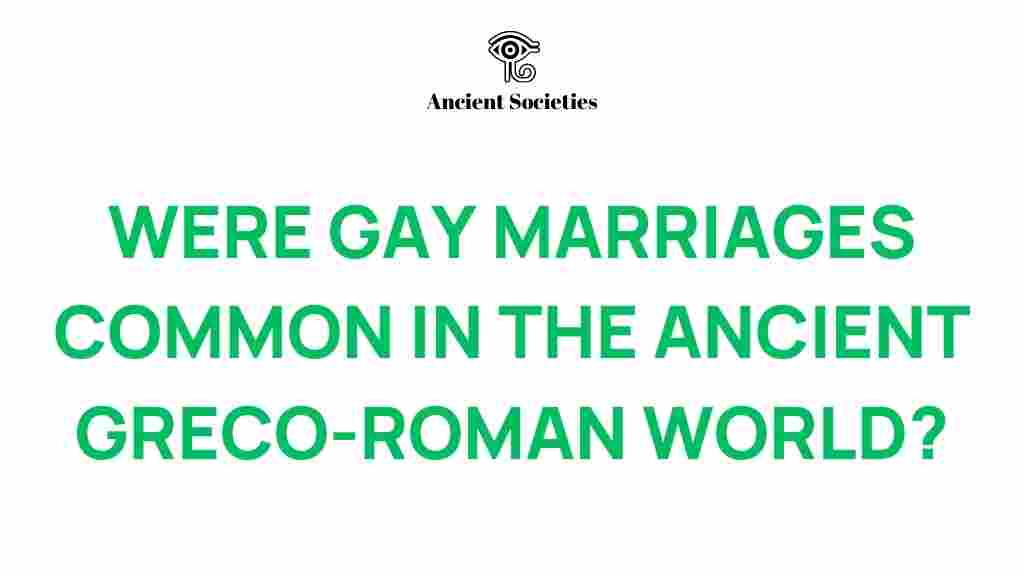Unveiling the Truth: Were Gay Marriages Common in Ancient Greece and Rome?
The concept of marriage has evolved significantly throughout history, shaped by cultural practices, societal norms, and the values of different civilizations. In this exploration, we delve into the intriguing topic of gay marriages in ancient Greece and ancient Rome, examining the historical evidence and societal perceptions surrounding LGBTQ+ history. Were same-sex unions accepted or even common in these ancient societies? Let’s uncover the truth.
Understanding Marriage Customs in Ancient Greece
Marriage in ancient Greece was primarily a social contract aimed at securing alliances and producing legitimate offspring. However, the relationships that men had with other men, particularly in the context of mentorship and love, were culturally significant.
- Institutional Marriage: Typically between a man and a woman, recognized by society.
- Paiderastia: A socially acknowledged romantic relationship between an older man and a younger boy, often involving mentorship.
While these relationships were not classified as marriages in the modern sense, they reflect a cultural acceptance of male same-sex relationships that existed alongside traditional marriages.
Exploring Ancient Roman Marriage Customs
In ancient Rome, marriage customs were also primarily heteronormative, emphasizing the importance of procreation and family lineage. Nevertheless, historical evidence suggests that same-sex relationships were present and, in some cases, socially accepted.
- Marriage as a Social Contract: Similar to Greece, Roman marriages were often arranged for political or economic reasons.
- Same-Sex Relationships: While not legally recognized as marriages, relationships between men were documented among the elite.
Prominent figures such as Julius Caesar and Emperor Nero engaged in notable same-sex relationships, illustrating that while these were not officially recognized as marriages, they played crucial roles in the lives of individuals.
Historical Evidence of Same-Sex Unions
Despite the lack of formal recognition, there is historical evidence suggesting that some form of gay marriages or ceremonies existed in both ancient Greece and Rome. Key texts and archaeological findings provide insight into these practices.
- Literature: Poets like Sappho and philosophers like Plato wrote extensively about same-sex love.
- Art and Artifacts: Vases and frescoes often depicted same-sex couples, indicating societal acknowledgment of these relationships.
- Legal Texts: Some Roman laws suggested protections for same-sex relationships, though these did not equate to marriage.
Societal Norms and Acceptance
Understanding the societal norms of both cultures is essential for contextualizing the acceptance of same-sex relationships. In ancient Greece, relationships between men were often idealized, especially in the context of mentorship. In contrast, ancient Rome had a more complex view, where same-sex relationships were often acceptable but could be subject to social hierarchies.
- Greek Norms: Male relationships were celebrated in literature and art, reflecting a cultural appreciation.
- Roman Norms: Acceptance varied based on social status; freeborn citizens were expected to take on a dominant role in same-sex relations.
Step-by-Step: The Evolution of LGBTQ+ Rights from Ancient Times to Today
To understand the trajectory of LGBTQ+ history from ancient times to the present, we can break it down into several key steps:
- Historical Context: Recognize the cultural practices of ancient civilizations regarding same-sex relationships.
- Documentation: Study the literary and archaeological evidence that reflects societal attitudes.
- Comparison: Compare ancient practices with modern understandings of marriage and LGBTQ+ rights.
- Current Trends: Analyze how historical perceptions have influenced contemporary views on gay marriages.
Troubleshooting Misconceptions about Gay Marriages in Ancient Cultures
Many misconceptions exist regarding the acceptance of gay marriages in ancient Greece and ancient Rome. Here are some common myths and the truths behind them:
- Myth: Same-sex relationships were entirely taboo in ancient societies.
- Truth: While not recognized as marriages, many same-sex relationships were accepted in various forms.
- Myth: All same-sex relationships were exploitative or unequal.
- Truth: Many relationships, particularly in Greece, were based on mutual affection and respect.
Conclusion: Reflecting on the Legacy of Gay Marriages in Ancient Societies
The exploration of gay marriages in ancient Greece and ancient Rome reveals a complex tapestry of relationships that defy modern categorizations. While formal marriages between same-sex couples may not have existed as we understand them today, the presence of same-sex love and partnership was significant and culturally acknowledged.
By examining these historical practices, we not only gain insight into LGBTQ+ history but also reflect on how cultural practices and societal norms shape our understanding of love and partnership across time. The legacy of these ancient societies continues to influence contemporary discussions on marriage and acceptance.
For further reading on LGBTQ+ history, consider visiting this resource. To learn more about the cultural practices of ancient societies, check out this article.
This article is in the category History and created by AncientSocieties Team
